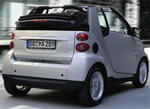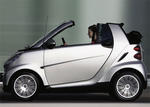
The history of the smart: “reduce to the max”
- 1997: The city mobile of the future becomes reality
- The smart fortwo as a consistent response to a wide range of mobility issues
- Practical means of transport, cult object and urban icon
- First concepts for an extremely compact and economical two-seater developed at Mercedes-Benz back in 1972
Stuttgart. Extremely compact, highly innovative and individual in self-assured style: the smart city coupe radically breaks with the automotive conventions of the 20th century. The car – today named smart fortwo – was introduced to the public
at the Frankfurt International Motor Show in 1997. At the same time, the smart brand of DaimlerChrysler – Daimler-Benz at the time – made its debut.
In its own unique way, the two-seater provides many answers to questions of individual mobility, especially in conurbations. It takes up little space, for instance, consumes very little fuel and emits minimum levels of carbon dioxide but still carries two people and their luggage to their destination – comfortably and safely.


Back in 1997, many of the mobility issues addressed appeared to come from a distant future, but the systematic approach pursued with the smart was clear for all to see. Never before had a production car with the smallest possible footprint been so cleverly designed down to the smallest detail. Since 1998, buyers in 36 countries have been opting for this unique car – a total of 770,256 units of the smart fortwo were produced between 1997 and 2006.
Numerous challenges have long since proved to be present-day rather than future issues. Since April 2007, the second-generation smart fortwo
has been on the market – with even more effective solutions. No other company has more extensive experience in this vehicle category to show for itself than DaimlerChrysler. This experience forms part of more than 120 years of automotive history which the company has been writing since 1886, and which boasts an abundance of constructive solutions to the problems of personal mobility.
The history of the smart is short but multi-faceted. The smart city coupe with gasoline engine came
onto the market in 1998, the diesel-engined version in 1999. The smart cabrio complemented the model lineup at a later stage. It was followed by the smart roadster, the smart roadster-coupe and the smart forfour – all of them history today. This is because the brand is now fully concentrating on the archetype of the smart – as the perfect response to a large number of pressing mobility issues.
The smart fortwo has long since become a cult car in many cities around the world. The German weekly “Die Zeit” coined the term “urban icon” for this car concept which set new standards in innovative mobility, the systematic incorporation of new technical features and a design which also visually highlights structural details.
The second-generation smart fortwo clearly continues the tradition of its predecessor as well as the fascinating smart story.
















